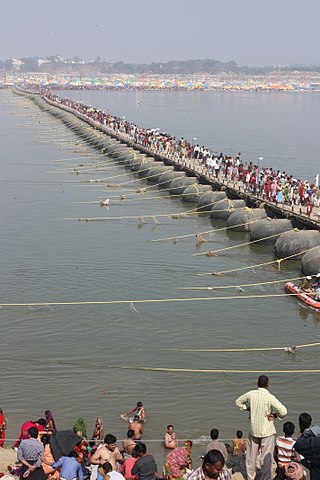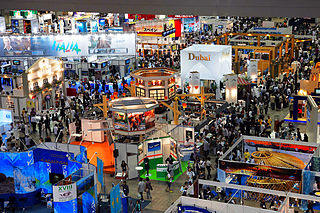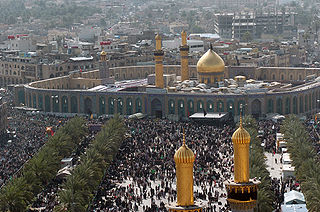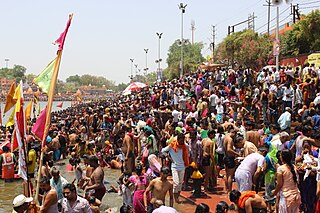Related Research Articles

A pilgrimage is a journey, often into an unknown or foreign place, where a person goes in search of new or expanded meaning about their self, others, nature, or a higher good through the experience. It can lead to a personal transformation, after which the pilgrim returns to their daily life.

Kumbh Mela or Kumbha Mela is a major pilgrimage and festival in Hinduism, On February 4, 2019, Kumbh Mela witnessed the largest public gathering. It is celebrated in a cycle of approximately 12 years, to celebrate every revolution Brihaspati (Jupiter) completes, at four river-bank pilgrimage sites: Prayagraj, Haridwar (Ganges), Nashik (Godavari), and Ujjain (Shipra). The festival is marked by a ritual dip in the waters, but it is also a celebration of community commerce with numerous fairs, education, religious discourses by saints, mass gatherings of monks, and entertainment. The seekers believe that bathing in these rivers is a means to prāyaścitta for past mistakes, and that it cleanses them of their sins.

A fair is a gathering of people for a variety of entertainment or commercial activities. Fairs are typically temporary with scheduled times lasting from an afternoon to several weeks. Fairs showcase a wide range of goods, products, and services, and often include competitions, exhibitions, and educational activities. Fairs can be thematic, focusing on specific industries or interests.

Mela is a Sanskrit word meaning "gathering" or "to meet" or a "fair". It is used in the Indian subcontinent for all sizes of gatherings and can be religious, commercial, cultural or sport-related. In rural traditions melas or village fairs were of great importance. This led to their export around the world by South Asian diaspora communities wishing to bring something of that tradition to their new countries.

There have been numerous incidents during the Hajj, the Muslim pilgrimage to the cities of Mecca and Medina, that have caused loss of life. Every follower of Islam is required to visit Mecca and Medina during the Hajj at least once in his or her lifetime, if able to do so; according to Islam, the pilgrimage is one of the Five Pillars of Islam. During the month of the Hajj, Mecca and Medina must cope with as many as three million pilgrims.

Allahabad Fort was built by the Mughal emperor Akbar at Prayagraj in 1583. The fort stands on the banks of the Yamuna, near its confluence with the Ganges. It is classified by the Archaeological Survey of India as a monument of national importance.
1954 Kumbh Mela "stampede" was a major crowd crush that occurred on 3 February 1954 at Kumbha Mela in Prayagraj in Uttar Pradesh state in India. It was the main bathing day of Mauni Amavasya, when the incident took place. 4–5 million pilgrims took part in the festival that year, which was also the first Kumbh Mela after India's Independence.

A walking tour is a tour of a historical or cultural site undertaken on foot, frequently in an urban setting. Short tours can last under an hour, while longer ones can take in multiple sites and last a full day or more. A walk can be led by a tour guide, as an escort.

Hajj is an annual Islamic pilgrimage to Mecca, Saudi Arabia, the holiest city for Muslims. Hajj is a mandatory religious duty for Muslims that must be carried out at least once in their lifetime by all adult Muslims who are physically and financially capable of undertaking the journey, and of supporting their family during their absence from home.
Short Cut to Nirvana: Kumbh Mela is a 2004 feature documentary film by Nick Day and Maurizio Benazzo about the 2001 Maha Kumbh Mela at Allahabad. The documentary premiered in the USA on May 11, 2004. The film won several awards on the festival circuit and played in theaters across the US and Europe.
On 10 February 2013, during the Hindu festival of Kumbh Mela, a stampede broke out at the train station in Allahabad, Uttar Pradesh, India, killing 42 people and injuring at least 45 people.

The Arba'in pilgrimage is the world's largest annual public gathering. It is a pilgrimage to the shrine of Husayn ibn Ali, grandson of the Islamic prophet Muhammad and the third Shia imam. Every year, on the twentieth of Safar, also known as Arba'in, millions of pilgrims flock to Karbala, Iraq, often arriving there on foot from the nearby city of Najaf. Arba'in marks forty days after the tenth of Muharram, known as Ashura. On this day in 61 AH, Husayn was killed, alongside most of his relatives and his small retinue, in the Battle of Karbala against the army of the Umayyad caliph Yazid ibn Mu'awiya. The battle followed Husayn's refusal to pledge his allegiance to Yazid, who is often portrayed by Muslim historians as impious and immoral. In Shia Islam, Karbala symbolizes the eternal struggle between good and evil, the pinnacle of self-sacrifice, and the ultimate sabotage of Muhammad's prophetic mission.
Ziyarat Arba'een is an annual pilgrimage that takes place in the holy city of Karbala in Iraq. It is the world's largest pilgrimage, reaching an estimated number of over 22 million pilgrims in 2023. The pilgrimage seeks to honour the martyrdom of the third Shi'ite Imam, Husayn ibn Ali, who was a grandson of Prophet Muhammad. Husayn was killed during the Battle of Karbala in 680 AD. In Arabic, "Arba'een" means "Forty", in reference to the 40th day after Husayn's martyrdom. "Ziyarat", on the other hand, means "Visit". While the visitation of Husayn is not considered an Islamic obligation, like Hajj, it plays an integral role in the religious life of Shia. The culture as stated by a researcher provides ways to express social emotion and from sociological perspective, feelings rules are ″appropriate ways to express internal sensation". So, also the ziyarat is directly or indirectly used to express the mourning of Imams. The Ziyarat Arba'een is a prayer which is usually recited on the day of Arba'een. It is narrated from Safwan al-Jammaal from Imam Ja'far al-Sadiq, the sixth Shiite Imam in which the Imam instructed him to visit Imam Husayn's mosque, and to recite a specific visitation prayer on Arba'een by which believer should reaffirm their pledge to Husayn's ideals. The Ziyarat or prayer is a text which designates Husayn as the "inheritor" of Adam, Noah, Abraham, Moses and Jesus.

Haridwar Kumbh Mela is a mela, associated with Hinduism and held in the city of Haridwar, India held every 12 years. The exact date is determined according to Hindu astrology: the Mela is held when Jupiter is in Aquarius and the Sun enters Aries. The event possesses deep religious significance to Hindus as well as other spiritual seekers. Historically, it was an important commercial event and was attended by merchants from as far as Arabia.

Ujjain Simhastha is a Hindu religious mela held every 12 years in the Ujjain city of Madhya Pradesh, India. The name is also transliterated as Sinhastha or Singhastha. In Hindi, the fair is also called Simhasth or Sinhasth. The name derives from the fact that it is held when the Jupiter is in Leo.

Nashik-Trimbakeshwar Simhastha is a Hindu religious mela held every 12 years in the Nashik district of Maharashtra, India. The name of the festival is also transliterated as Sinhastha or Singhastha. It is one of the four fairs traditionally recognized as Kumbha Melas, and is also known as Nashik-Trimbak Kumbha Mela or Nashik Kumbha Mela.

The Prayag Kumbh Mela, also known as Allahabad Kumbh Mela is a mela, or religious gathering, associated with Hinduism and held in the city of Prayagraj, India, at the Triveni Sangam, the confluence of the Ganges, the Yamuna, and the mythical Sarasvati river. The festival is marked by a ritual dip in the waters, but it is also a celebration of community commerce with numerous fairs, education, religious discourses by saints, mass feedings of monks or the poor, and entertainment spectacle. Approximately 50 and 30 million people attended the Allahabad Ardh Kumbh Mela in 2019 and Maha Kumbh Mela in 2013 respectively to bathe in the holy river Ganges, making them the largest peaceful gathering events in the world.

A suicide bombing occurred in Iraq on 24 November 2016 when a truck bomb exploded at a petrol station in Hillah, some 100 kilometers from southern Baghdad, killing at least 125 people and injuring many others.

The COVID-19 pandemic affected the 2020 Hajj (pilgrimage), which is the fifth pillar of the Five Pillars of Islam, where millions of Muslims from around the world visit Mecca and Medina every year during Hajj season for a week. Over 2,400,000 pilgrims attended Hajj in 2019. Due to the highly contagious nature of COVID-19 in crowded places, various international travel restrictions, and social distancing recommendations, the Ministry of Hajj and Umrah advised Muslims to postpone their pilgrimage until the pandemic was mitigated. However, in June 2020, the Ministry opened up Hajj to people of all nationalities residing in Saudi Arabia, with foreigners still banned from attending to ensure pilgrims' safety and prevent the transmission of COVID-19.
References
- ↑ "4º Encontro da Rede CIEVS (Centro de Informação em Saúde para Viajantes)" [Brazil- Conference: The 4th Annual Meeting of the CIEVS network], Mass Gathering Guidelines= OEI, 2010-10-28
- ↑ Ranse, Jamie; Hutton, Alison (December 2012). "Minimum Data Set for Mass-Gathering Health Research and Evaluation: A Discussion Paper". Prehospital and Disaster Medicine. 27 (6): 543–550. doi:10.1017/s1049023x12001288. ISSN 1049-023X. PMID 23174040. S2CID 45404363.
- ↑ Managing health risks during mass gatherings retrieved 25 Jan 2023
- ↑ Hajj Information retrieved 30 Jan 2023
- ↑ 21 million Shiites mark Arbaeen in Iraq's Karbala retrieved 30 Jan 2023
- ↑ Kerman pays homage to Lieutenant General Qassem Soleimani retrieved 6 Feb 2023
- ↑ 1.4 crore people take dip as Kumbh Mela begins retrieved 30 Jan 2023
- ↑ Mauni Amavasya: Sangam turns into biggest confluence of human faith as 5 cr devotees take dip retrieved 30 Jan 2023
- ↑ Photos: One million Muslims start Hajj pilgrimage in Mecca retrieved 30 Jan 2023
- ↑ https://en.irna.ir/news/83522737/Arbaeen-pilgrims-count-hits-18-million Arbaeen pilgrims count hits 18 million]
- ↑ "Public Health Preparedness for Mass Gatherings". Archived from the original on 2018-02-06. Retrieved 2010-11-04.
- ↑ "Mass Gatherings and Public Health" (PDF). 2007. Retrieved 2010-11-04.
- ↑ "Communicable disease alert and response for mass gatherings" (PDF). Retrieved 2010-11-04.